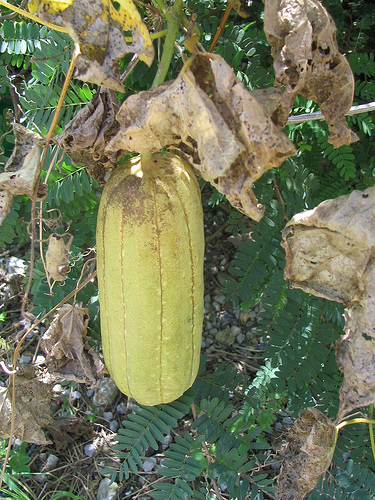
Loofah gourd (luffa cylindrica) by Laura512
Paraguayan innovator Elsa Zaldívar has won the 2008 Rolex Award for Enterprise thanks to her project which consists of not only training women heads of households about processing the luffa cylindrica gourd to make bath scrubbies and sandals, but also in mixing the leftovers of the vegetable sponge with recycled plastic and turning it into a strong material which can be used to make walls, a technology which might save the forests by substituting wooden planks for the plastic composite.
In the following video [en], Elsa speaks about her Paraguay: the low cost housing shortage, the quickly shrinking forests and the pollution caused by plastics, and how this project can address all of these issues:
So, what is a luffa? It is a type of gourd that grows on a climbing vine. Some varieties can be eaten when young, others are bitter, but mostly the luffa (or loofah) is famous for being a bath sponge, used as an exfoliating agent to remove dead skin cells while in the shower. On the cmc-cmc blog [en], the author took pictures and videos of a farmer harvesting loofah gourds, peeling and cleaning them right on the spot. On the blog post, he also mentions that the seeds are sometimes ground to make a natural remedy against high blood pressure.
WilliamSabber on YouTube [pt] made this short video from the garden of Mr. Adair Satler in Brazil, when he saw a really long loofah gourd, easily surpassing 120 cm (47 inches):
The good news is that in Paraguay, the loofah industry is up and growing, and some NGO's like OIPIC [es] are promoting its farming as a way for families to be able to compete with the soy or cotton industries. The loofah can be used as a filling for furniture or car seats, for making handbags, shoes, and bath sponges, insoles, sandals, as pot scrubbers (they are safe for use with metal non-stick pans), as an ingredient for natural hand-made soaps and even medication against sinus problems. Another benefit for loofah planting is that because it flowers year round, it is great for bee-keping, to keep a colony healthy, well fed and increase honey production, as the Bees for Development [en] website states. And well, it seems that now, thanks to Elsa Zaldívar, it will be a staple for construction as well.







2 comments
Is there a source for the variet(y/ies) of seeds of the very long loofah?
Thanks in advance for any trouble you go to to help me find them.